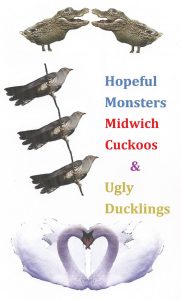
Throughout the evolution debate, many evolutionists have speculated that some aspects of evolutionary change might occur in jumps, otherwise known as saltations. For instance, in 1926, a Dutch anatomist, Louis Bolk, proposed, in his Neoteny Theory, that humans are overgrown ape foetuses which have not matured properly. Neoteny has invariably been regarded as a saltation.
In the 1930s, a German biologist called Richard Benedict Goldschmidt went further than most previous saltationists by proposing that the most influential factor in evolution was not the contents of the chromosomes – the as-yet hypothetical genes – but the configurations of the chromosomes themselves. He noted that what differentiated one species from another was the size, shape and even number of its chromosomes. Therefore, he argued, species transition involved chromosomal changes. Though small scale evolution could be taking place within a species at the level of genes, on the basis of regional variations and population shifts, major evolution took place at the level of chromosomes. He claimed that, every now and then, random chromosomal changes threw up a ‘hopeful monster’, which did not resemble its parents at all, since it was effectively the first example of a new species. Most hopeful monsters would not make it beyond one generation, but occasionally a hopeful monster would be much better at surviving than its parent stock so its monstrous descendants would grow in number as the other, normal descendants of the parent stock dwindled.
The main problem with the Hopeful Monster hypothesis concerns breeding. If Goldschmidt had been able to postulate a ‘Midwich Cuckoos’ scenario, in which a whole clutch of similar hopeful monsters were all born at around the same time and place, there would have been no problem, but a one-off mutant animal would not only suffer from the ‘Ugly Duckling’ syndrome and have difficulty finding a mate, but he or she might not be able to breed with the parent stock, due to the chromosomal differences. However, there is another way in which there could be more than one hopeful monster, which relies on two-step changes in chromosome number, and which I shall exemplify with regard to human evolution.
We humans have 46 chromosomes each. Gorillas and chimps have 48 chromosomes each. That does not mean that we have less genetic material than gorillas and chimps. It just means that at some point in our evolution from a common ancestor, the material in its chromosomes became shuffled about by either amalgamations or splits. Let us assume, using Occam’s Razor (which dictates that one always takes the straightest path from A to B), and because it fits in with Goldschmidt, that the common ancestor of humans, gorillas and chimps had 48 chromosomes. In accordance with the Theory of Descent, at some point after we split from them, there must have been an individual who had 47 chromosomes, the material from one of its previous 48 having become amalgamated with others. Whether or not it was a visible ‘Ugly Duckling’, that individual must have been able to breed with 48-chromosome individuals to produce progeny with either 47 or 48 chromosomes. 47-chromosome individuals must have been survivors, and their numbers must have increased. In the fullness of time, 47-chromosome individuals would have bred with each other to produce progeny with 46 or 47 or 48 chromosomes in the Mendelian ratio of 1:2:1.
Let us further suppose that 47-chromosome individuals were not ‘Ugly Ducklings’, due to the phenomenon known as masking, but 46-chromosome individuals were. The scene had been set for there to be more than one ‘Ugly Duckling’ in existence, since there could have been plenty of 47-chromosome individuals breeding with each other, so the 46-chromosome ‘Midwich Cuckoos’ could breed with each other to produce reliable 46-chromosome progeny. The evidence that we now have suggests that 46-chromosome individuals were much fitter, for survival and reproduction within the specific environment, than the original 48-chromosome individuals. In Goldschmidt’s terms, they were successful ‘hopeful monsters’, and they were the most significant step on the road to becoming human. Since most people would probably agree that chimps and gorillas are more similar to each other than either of them are to us, that would seem entirely reasonable. It also fits with Bolk’s Neoteny Theory, neoteny having been triggered in the 46-chromosome individuals. The most significant qualitative difference between us and other apes is the timing and form of our maturation.
The Hopeful Monster hypothesis did not really catch on, which is unfortunate because I think Goldschmidt was onto something in his insistence that chromosome configuration is important. Like Einstein before him, Goldschmidt had the wisdom to emigrate in 1935 to America, where his contributions to evolution theory were influential, largely because they were held up to ridicule, but they were never adopted.
